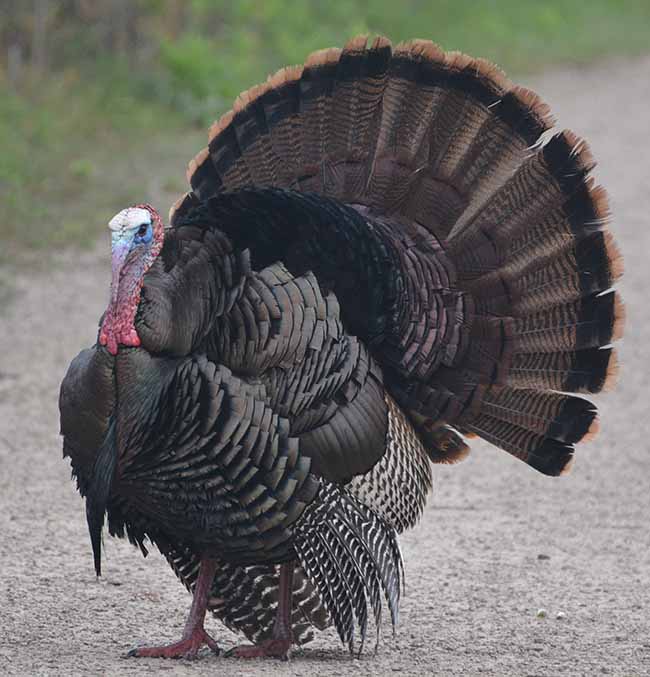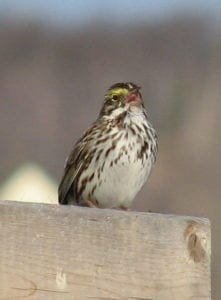
Gallinaceous birds, such as turkeys, partridge and pheasants, couple vocalizations with strutting and posturing to show off their plumage – Photo by Geoff Carpentier
 Ah spring, a time for flowers and April showers, birds and bees, a chorus of frogs, greening of the earth and love at first sight.
Ah spring, a time for flowers and April showers, birds and bees, a chorus of frogs, greening of the earth and love at first sight.
Well, wild things don’t actually fall in love, since reproduction is a serious business that involves advertising for the sole purpose of mating.
We’re all very familiar with spring birdsong – those melodic sounds that replace the solitude of winter. Robins, wrens, cardinals and so many more species bring peace to all who listen as they flaunt their lovely plumage and pour out their flute-like or warbling songs.
While many birds have beautiful songs, others are really more squawkers than singers – the crows and grackles come to mind. It’s not really ear-pleasing but song nonetheless.
Sparrows fall mid-scale in the singing contests, with some better than others. Song, fox and white-throated sparrows are quite melodic, while Savannah and grasshopper sparrows are more insect-like in their offerings.
But regardless of how well they sing, the purpose is always the same: find, attract and keep a mate – at least until breeding has occurred, that is.
Male birds are sometimes fickle and chase anything with feathers, and other times they’re the best protectors of their prospective mates – it really is quite variable.
But rest assured they will sing each spring, usually first thing in the morning for extended periods and then periodically throughout the day, often with a shortened evening chorus to reassert their territorial claims.
And that brings us to the second primary reason birds sing: to find and keep a territory. There’s no joy in singing, as poets would have you think. Once the female has been found and nesting begins, many males will defend a territory against all intruders and quite aggressively chase interlopers off.

Rather than melodic, a Savannah sparrow’s song is more insect-like – Photo by Geoff Carpentier
With some species, it can be quite amusing (to us but not the birds, I’m sure). Have you ever seen a cardinal fight with its own image in a reflective window or car mirror?
It may seem quite entertaining as they attack their own reflection repeatedly, thinking it’s a competitor invading their territory. But it can also be dangerous to the bird, as they can break their beak or use so much energy they die.
But spring love is also about other things and watching the birds can be fascinating, for song is coupled with sometimes spectacular displays:
- Hummingbirds do an elaborate pendulum-like flight, where the males zoom back and forth over the female.
- Woodcock and snipe fly high over wet woods and marshes, to call their mates.
- Goldfinches also fly high in broad circles, vocalizing all the time at high volume.
- Woodpeckers use trees that resonate sound to show their interest.
- Gallinaceous birds, such as turkeys, partridge and pheasants, couple vocalizations with strutting and posturing to show off their plumage.
Other birds are more subdued and may not display aggressively, but every one does to some degree – even if it’s too subtle for us to see.
Spring is also about food. The defence of a territory ensures a male can find a mate, can breed and that enough food will be available to feed the offspring.
Courting birds may also use food in another way. Courtship feeding is a mating ritual where a male offers a female a food morsel, partly to win her favour, but also to strengthen the growing bond between them.
Cardinals and waxwings are particularly adept and often share a berry in a moving moment of ‘bird love.’ Other species do this as well, but the impact is sometimes lost in the food being shared – how appealing is a worm, a squirming fish or a juicy bug?
Well, beauty is in the eye of the beholder!
So spend a few minutes to enjoy the orchestral offerings of our native birds as they launch into the songs of spring. Maybe you can see some love in the air or even more as you pry into the private lives of birds in love.
Geoff Carpentier is a published author, expedition guide and environmental consultant. Visit Geoff online at www.avocetnatureservices.com, on LinkedIn and on Facebook.
The views, opinions and positions expressed by columnists and contributors are the author’s alone. They do not inherently or expressly reflect the views, opinions and/or positions of our publication.

